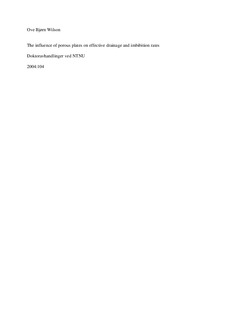| dc.contributor.author | Wilson, Ove Bjørn | nb_NO |
| dc.date.accessioned | 2014-12-19T12:14:09Z | |
| dc.date.available | 2014-12-19T12:14:09Z | |
| dc.date.created | 2004-11-08 | nb_NO |
| dc.date.issued | 2004 | nb_NO |
| dc.identifier | 126203 | nb_NO |
| dc.identifier.isbn | 978-82-471-6426-4 | nb_NO |
| dc.identifier.uri | http://hdl.handle.net/11250/239291 | |
| dc.description.abstract | The goal in petrophyscial studies is very often to obtain representative capillary pressure curves in conjunction with Sw-RI relationships for log interpretation. The most frequently used techniques today are centrifugation, the porous plate and the mercury injection techniques.
Unlike the other methods, the strength of the porous plate technique is the possibility to establish both primary drainage, spontaneous imbibition, forced imbibition and secondary drainage without changing set up, conditions or method. In addition, the technique can be combined with resistivity measurements. The weakness is that the method requires a long experimental turnaround time.
Even though techniques like the membrane technique6, the continuous injection technique7, and the semi dynamic method8 have been introduced to the industry with a significant reduced turnaround time, the porous plate method is still believed to be the most representative method.
Its popularity in special core analysis has not dropped even after these new techniques were introduced to the industry.
The aim of this study is to experimentally test layered porous plate prototypes in capillary experiments for different capillary sequences, using all types of fluid pairs at different conditions, varying from ambient to extreme reservoir condition. The layered porous plate method is identical to the porous plate method, except for ceramic construction. In addition to this, the aim is to investigate if there is possible hysteresis between the two porous plate techniques, and investigates if this is related to reduced turnaround time. In other words, investigate how and when diaphragms influence drainage and imbibition rates in capillary experiments.
Another aim is to investigate if the layered porous plate technique can improve the continuous injection technique.
In this study a method of quantifying the influence of porous plates on effective rates at any stage and capillary sequence has been developed. The method is based on analysing transient capillary behaviour. | nb_NO |
| dc.language | eng | nb_NO |
| dc.publisher | Institutt for petroleumsteknologi og anvendt geofysikk | nb_NO |
| dc.relation.ispartofseries | Doktoravhandlinger ved NTNU, 1503-8181; 2004:104 | nb_NO |
| dc.subject | Reservoarteknikk | no_NO |
| dc.title | The influence of porous plates on effective drainage and imbibition rates | nb_NO |
| dc.type | Doctoral thesis | nb_NO |
| dc.source.pagenumber | 152 s.ill | nb_NO |
| dc.contributor.department | Norges teknisk-naturvitenskapelige universitet, Fakultet for ingeniørvitenskap og teknologi, Institutt for petroleumsteknologi og anvendt geofysikk | nb_NO |
| dc.description.degree | dr.ing. | nb_NO |
| dc.description.degree | dr.ing. | en_GB |
